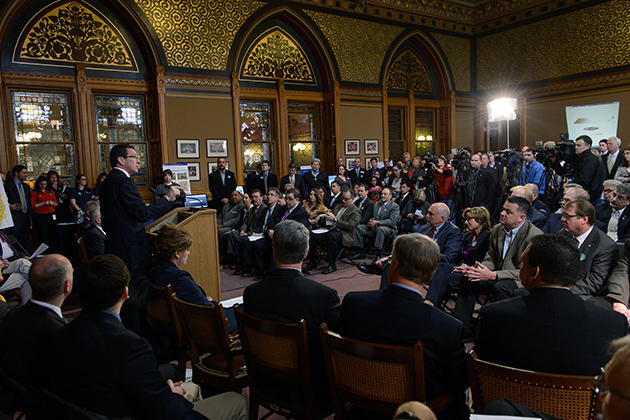
More than 100 corporations, trade and labor groups, local businesses, and other entities concerned with strengthening Connecticut’s economic development and job creation efforts have signed on to endorse the Next Generation Connecticut proposal.

Connecticut Gov. Dannel P. Malloy, University of Connecticut President Susan Herbst, legislative leaders, and representatives from several of the supporting businesses and organizations revealed the full list at an event at the State Capitol on Thursday.
They range from Fortune 500 companies to chambers of commerce, labor and trade organizations, research groups, local and regional businesses, and other entities. The list continues to grow, with new corporate supporters stepping forward on a steady basis to endorse the initiative.
“They understand they need human capital to compete with the rest of the world,” Malloy told the crowd Thursday, outlining the need for an innovation-based economy and Next Generation Connecticut’s potential to help drive job creation in high-tech fields.
“These are important investments that will allow us to be successful not in the past, but in the future – not with yesterday’s technologies, but with tomorrow’s technologies,” Malloy said. “It also ensures we will be competitive to keep the jobs we have in the state and attract others.”

Next Generation Connecticut (#NextGenCT) is a multi-faceted plan to build the state’s economic future through strategic investments in science, technology, engineering, and math disciplines (STEM) at the University of Connecticut.
It involves leveraging UConn’s resources to fuel Connecticut’s economy with new technologies, highly skilled graduates, new companies, patents, licenses, and research innovations leading to more high-wage STEM jobs in the state.
“I’ve said it everywhere I have gone and I’ll keep saying it: This proposal is not about the governor and the legislature wanting to ‘do something for UConn.’ Quite the opposite – it’s about what Connecticut’s leadership wants UConn to accomplish for this state, its people, its businesses, and its economy,” Herbst said Thursday.
“It’s something that the University is perfectly positioned to do. Next Generation Connecticut was tailored to utilize UConn’s specific, unique assets and abilities as a research institution,” she said.
The return on investment in the NextGen proposal was also attractive to state leaders and business officials at Thursday’s event. The initiative is estimated to bring in $270 million in new research dollars over 10 years, spur well over half a billion dollars in business activity, and support more than 4,000 permanent jobs, plus 30,000 construction jobs.

The dozens of companies, trade groups, labor and civic organizations, and others who have signed on to endorse the initiative come from throughout the state and a variety of industries.
Several companies endorsing the initiative already have invested significantly in building a STEM workforce for their companies and industries, and praise Next Generation Connecticut’s opportunities for research partnerships.
“We have spent years collaborating with research agencies and universities like UConn to advance our hydrogen generation technology, and have witnessed the impact that partnerships have on scientific innovation and economic growth,” said Robert Friedland, co-founder, president, and CEO of Wallingford-based Proton OnSite.
“We believe in Next Generation Connecticut’s mission, and share the initiative’s commitment to encouraging the next generation of engineers and spurring innovation in Connecticut,” Friedland says.

Friedland was among several speakers at Thursday’s event. Others included State Senate President Pro Tem Donald Williams Jr.; House Speaker Brendan Sharkey; Edmond Murphy, senior director of technology planning and intellectual property at JDS Uniphase in Bloomfield; John Rathgeber, president and CEO of the Connecticut Business & Industry Association; and Lori Pelletier, secretary-treasurer of the Connecticut AFL-CIO.
The initiative includes expanding enrollment and faculty at UConn, and renovating and adding appropriate facilities in STEM disciplines to put students and faculty at the forefront in research in everything from biosciences to thermodynamics, agricultural sciences, and pharmaceutical advances.

The Stamford campus curriculum would also be expanded with a strong focus on digital media and business programs in fields with fast-growing employment opportunities, and UConn would establish the nation’s first STEM honors program.
The proposal involves a 10-year, $1.5 billion capital component outlined in Senate Bill 840, An Act Concerning Next Generation Connecticut, which currently awaits legislative action. The commitment to the initiative is a shared fiduciary responsibility, with UConn contributing $235 million for the building program and $149 million in operating funds to support the academic program components.
In addition to bolstering job creation in high-tech STEM fields and driving innovation, Next Generation Connecticut would create 30,000 construction jobs through 2024.



